
Comets
The situation is a little on the quiet side comet-wise. The previously-covered Comet C/2022 E3 (ZTF), which gained much publicity at the end of last year and the beginning of this, is thought to be in outburst. As it is on its way out of the inner solar system, the maximum brightness this outburst is predicted to reach is 10th magnitude. This comet is the preserve of observers further south than 40 degrees N at present though.
C/2021 S3 (PANSTARRS) is looking like it may reach 5th/6th magnitude early next year and may be a nice binocular target and there is also C/2023 A3 to come, but this is still a considerable distance from the Sun and the comet has a long way to go before reaching the inner solar system. Further observations will determine if it is going to be a naked eye spectacle (which is looking less likely from recent brightness reports), or just a reasonable binocular target.
Meteors
There are no major meteor events in June, though being out under clear skies, there is always the chance of observing a sporadic meteor or two, during any clear night. The next shower to be on looking out for are the Southern Delta Aquariids in late July/early August.
Noctilucent Clouds
Noctilucent Clouds are often seen in June - their bright gossamer/web-like structures can normally be seen low on the northerly horizon, between latitudes of 50-65 degrees, when the Sun is between 6 and 16 degrees below the horizon. These clouds are mysterious - there were no recorded sightings of them before 1885. Some researchers believe they are formed as a result of volcanism, human-induced atmospheric pollution, or even the condensation of water vapour along the trails of meteors. Interestingly, a significant link between the power of the Northern Polar Stratospheric Vortex and the production of NLCs in the Southern Polar Mesosphere (the atmospheric layer above the Stratosphere) has been found by analysis of ground based data and that gleaned form NASA climate satellites. It would appear that when the Northern Polar Vortex is particularly strong, this negatively affects the production of NLCs over the Southern pole over 12,000 miles away. These interconnections are a sure sign of how little we truly understand the mechanics of the atmosphere of our home planet and how much is still potentially to be uncovered.
Whatever their origins, now is the best time to see NLCs from Northern latitudes. Interestingly, whilst Noctilucent Clouds have been observed in the Southern Hemisphere, their incidence appears much fewer than their Northern Hemispherical counterparts.
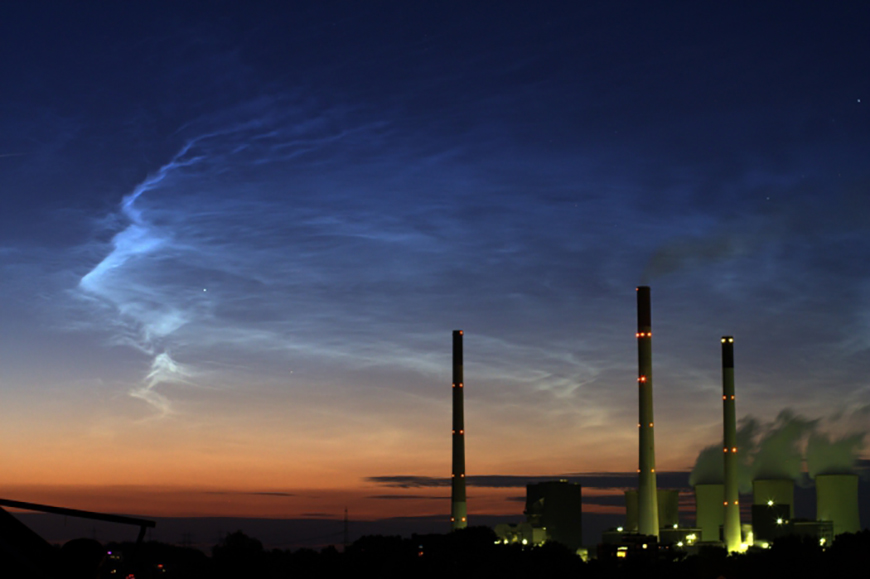
A spectacular NLC display captured by Bresser's Anke Morbitzer. Check out Anke's other pictures of the sky and atmospherics at http://astroyuki.com. Image used with kind permission.
Deep Sky Delights: Galaxy Season part 3, Virgo
Picking up from where we left off Leo last month, we move south and east, over the border into the large and extremely galaxy-rich constellation of Virgo.
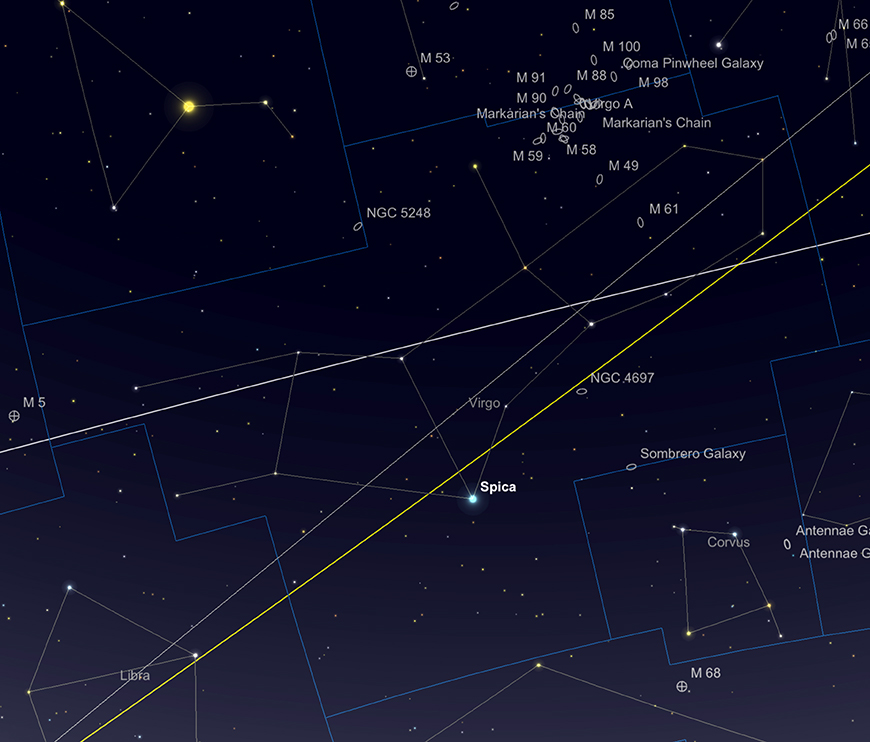
Virgo. Image created with SkySafari 5 for Mac OS X, ©2010-2016 Simulation Curriculum Corp., skysafariastronomy.com.
The so-called "Bowl of Virgo", which comprises of the most northerly section of the constellation is where the majority of the objects discussed below lie. So crammed in are these galaxies that it is difficult to see in the larger scale map above exactly where these mass of objects lie in relation to one another. The image below is a more detailed depiction of the "Bowl' area, which really gives an indication how crowded this area is.
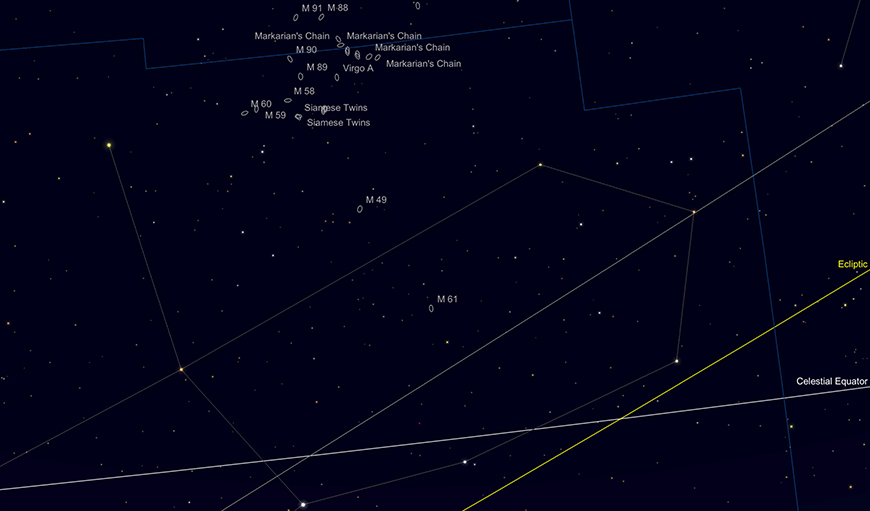
The Bowl of Virgo. Image created with SkySafari 5 for Mac OS X, ©2010-2016 Simulation Curriculum Corp., skysafariastronomy.com.
The galaxies shown in the map above are just the brightest and easiest to observe in this area of sky. There are many more fainter galaxies lurking in the background, making up the Virgo cluster of galaxies. Indeed, it is thought that the interlinked Virgo Supercluster, which comprises of galaxies in neighbouring Leo, right the way through Ursa Major and our own local group of galaxies, is one of the largest structures in the known Universe.
Just under a degree SSW of M88, where we left off last month, lies the small +10.19 mag spiral galaxy of NGC 4477, which in turn marks the beginning of a glorious 1.5 degree long arc of galaxies known as Markarian's Chain. This gently curving line of galaxies is one of the finest sights in the sky and an almost peerless photographic subject from a galaxial point of view.
Markarian's Chain comprises of the aforementioned NGC 4477 at the Northerly end and the major galaxies M84 (elliptical, +9.10 mag), M86 (lentinicular, +8.89 mag), at its Southerly tip. Galaxies NGC 4473 (elliptical +10.19 mag), NGC 4461 (spiral +11.19 mag), NGC 4458 (elliptical +12.10 mag), NGC 4438 and NGC 4435 (both spiral, +10.80 mag, together known as "The Eyes"). The Chain spills over the Coma Berenices border into Virgo, where the largest part of it resides.
Markarian's Chain is named after the Armenian Astrophysicist Beniamin Markarian, who in the early 1960s first suggested a common motion for all these galaxies. Observations have proved than all the above galaxies are in fact gravitationally interacting with each other, though there are outlying and closer objects - most noticeably the spiral NGC 4388 which may, or may not, be a part of the system - which also populate the area.
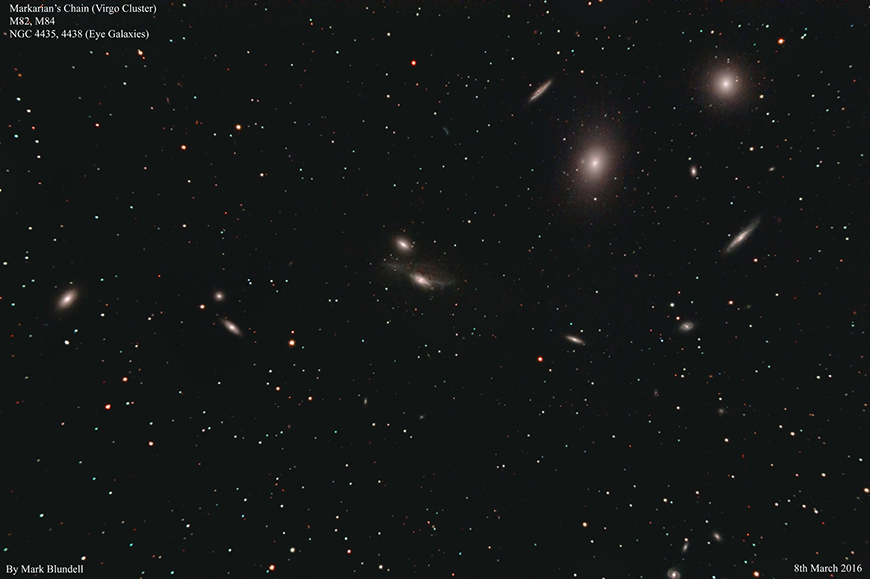
Markarian's Chain by Mark Blundell. Image used with kind permission.
Frankly, it's difficult to pick out clear highlights in Markarian's Chain, but special mention must go to the eerily-named "The Eyes" galaxy pairing of NGC 4438 and NGC 4435. This pairing do appear like a pair of eyes peering back at an observer through the gloom and were first nicknamed this by late-19th and 20th century astronomer L.S. Copeland. Looking at these two objects in even a relatively small telescope will confirm this nickname's accuracy - the similar galaxial core brightness and angular orientation of both objects help to complete the illusion. Both galaxies it is clear have gone through some sort of interaction in the recent past as astrophotography reveals a large amount of stellar and dark material spilling from NGC 4438's disk.
A degree to the SE of the eyes lies the vast elliptical galaxy M87, otherwise known simply as Virgo A. This enormous object is easily picked up in amateur instruments from even fairly light polluted environments, shining as it does at +8.60 mag. M87 was discovered and catalogued by Messier in 1781.
To call M87 vast is to somewhat understate the case: it is estimated to be anything up to 200 times the mass of our own Milky Way galaxy and has over 12,000 globular clusters in orbit around it, compared to our galaxy's rather paltry estimated 150-200. M87 also appears to be close to the gravitational centre of the Virgo-Coma Supercluster and may be the key gravitational driver of the whole system. Astrophotography reveals a large jet emanating from M87's centre. This was first recorded by Lick Observatory Astronomer H.D. Curtis in 1918 and a corresponding much fainter opposite jet was discovered in 1966. These jets mark at their epicentre one of the most massive black holes so far postulated - a 2-3 billion solar mass object, condensed to about the volumetric size of our solar system. It is thought to be this object that makes Virgo A one of the most energetic sources of X-Rays, Radio Waves and Gamma Rays in the sky.
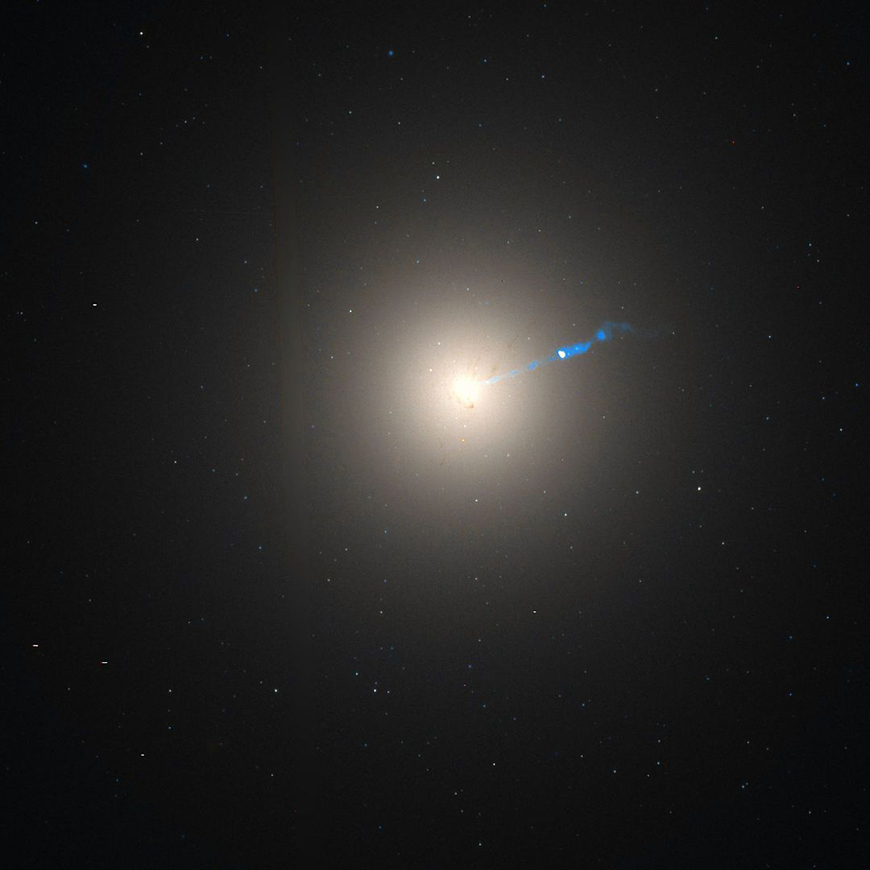
Virgo A, Hubble Space Telescope image, ESA/NASA. Public Domain.
This remarkable monster galaxy can be easily spotted in decent sized binoculars from a reasonable location and is one of the most straightforward galaxies to observe in the sky. To give a sense of scale, M87 lies 55 million light years away and its outer extents observable from here on Earth cover an area of sky larger than the full Moon. If put in place of M31, the Andromeda Spiral, in our skies, M87 would probably fit into an area the size of the Square of Pegasus - it's that big! However, even the mighty M87 pales in comparison to the galaxy IC1011 (also in Virgo) which takes the prize of the largest galaxy currently known at a staggering 6 million light years across - 60 times the size of our Milky Way's 100,000 light year span.
Just over a degree E of M87 lies another elliptical galaxy: M89. This Messier-discovered object is fairly bright and compact at +9.80 mag and 3.5 x 3.5 arc minutes in size. M89 is a remarkably spherical object, or at least appears to be from our perspective. This is unusual, as most elliptical galaxies do appear slightly elongated. M89 is rather special in terms of its conformity. This makes for an easily observed object in most telescopes, but unfortunately, a rather bland experience.
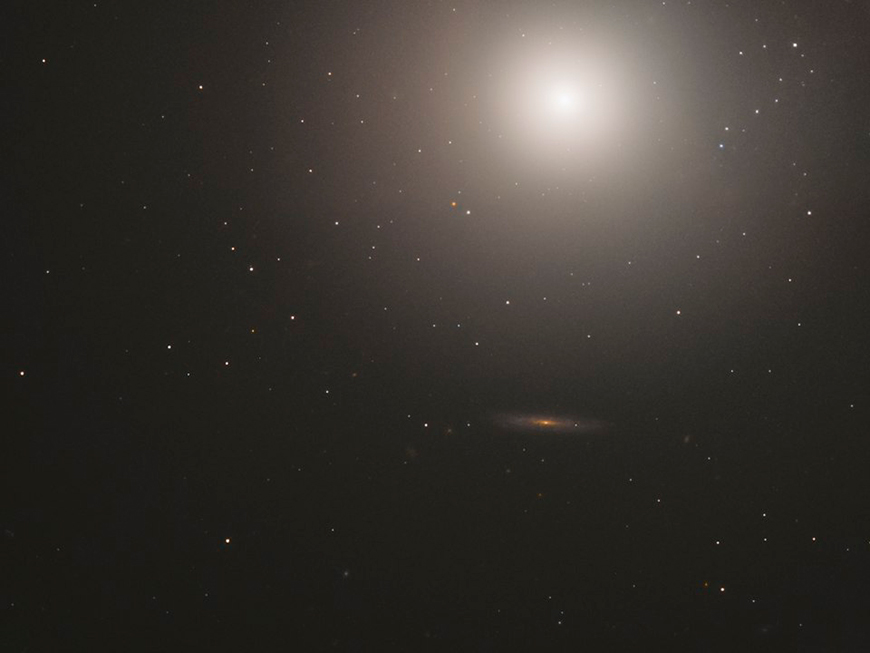
M89, Hubble Space Telescope image, Hubble/ESA. Creative Commons.
Whereas the unfortunate M89 is fairly bland, its neighbour, M90, to be found 3/4 of a degree to the N is anything but. At +9.50 mag and an angular size of 9.5 x 4.4 arc minutes, it is a touch difficult in binoculars in comparison with its two elliptical neighbour, but is well-seen as a elongated spiral in larger telescopes. M90 is fairly unique amongst Messier galaxies, as its spectral shift is very pronounced towards the blue side of the spectrum, suggesting it is rapidly approaching us in relation to the rest of the cluster. This may be due to it having broken free of the gravitational bounds of the cluster, or indeed it may be considerably closer than the 50-or-so million light years distance it is thought to lie. Another interesting feature of M90 is that star formation appears to have ceased almost entirely within the system. As such it is referred to as a "Fossil Galaxy". M90's swift flight through the interstellar medium is thought to have stripped it of much of its star forming material via the process known as "Ram Pressure Stripping". This appears to also have been compounded by several supernovae in its central arm regions, which would naturally be richer in this material. The combined stellar winds from these events have blown much of the material out of the galactic disk and out of the gravitational influence of the galaxy.
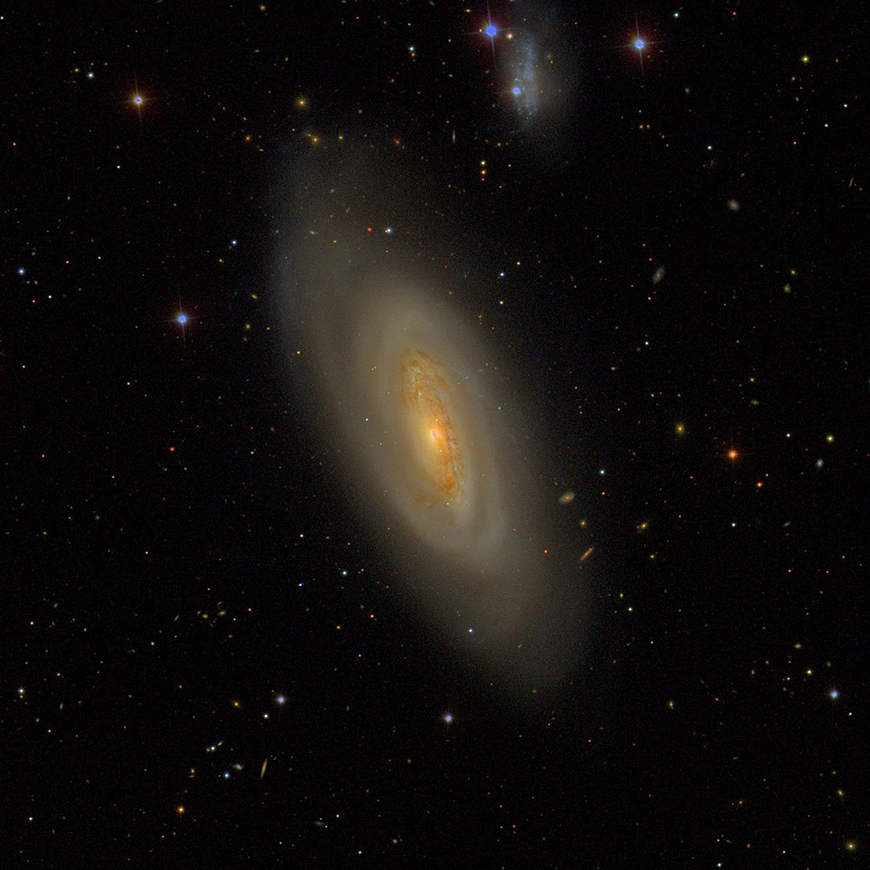
M90. Image credit: Sloan Digital Sky Survey [www.ssds.org] Creative Commons.
One and 1/3 degrees S of M90 lies another spiral galaxy, M58. Although M58 is a little fainter than M90, at +9.69 mag, it appears, due to its compact size - 6.0 x 4.8 arc minutes - a little brighter overall. M90 is a barred spiral, though due to the relative brightness of its spiral arms, the bar appears a little obscure, particularly in smaller telescopes - though these will show its disk shape well. Larger instruments will start to resolve the mottled internal structure and arms better, with the central bar becoming more obvious in instruments of the 8-10-inch class. M58, alongside M90 is a relatively poor galaxy for star formation and seems to be a victim of the dreaded Ram Pressure Stripping as well. Lying some 62-68 million light years away (sources differ) it is suggested that at the time of its discovery by Messier in 1779, it was the furthest observed object in the Universe.
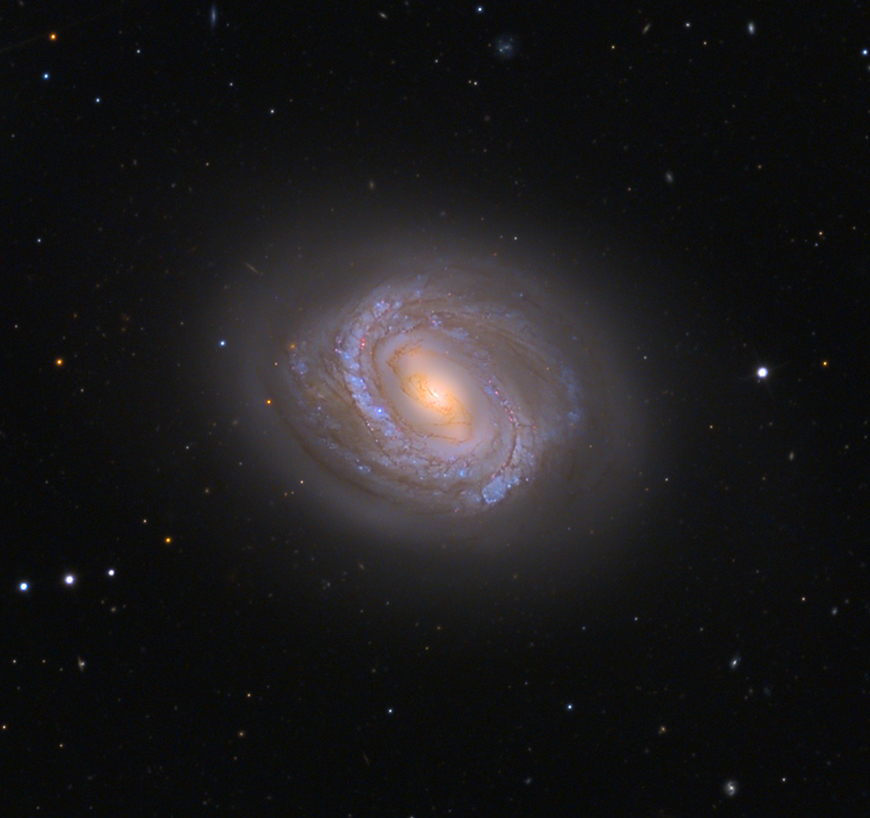
M58 taken with the 0.8m Shulman Telescope. Image credit: Adam Block/Mount Lemmon SkyCenter/University of Arizona - http://www.caelumobservatory.com/gallery/m58.shtml. Creative Commons.
Just over a degree to the E of M58 lie the first of two elliptical galaxies, M59 and M60 (a little under half a degree further E). These two galaxies were first discovered by Johann Gottfried Koehler in April 1779, Messier listing them shortly after. Both men were principally concerned with comet watching rather than any notion of "Deep Sky" objects - ironically their discoveries of these pesky objects getting in the way of "true" comets would ultimately be of much greater cosmic significance.
Of the two galaxies, M60 is dominant, being +8.8 mag to M59's +9.6 and slightly larger at 7.6 x 6.2 to M59's 5.4 x 3.7 arc minute size. Still, M59 in a large telescope is a fine object, displaying a bright outer halo, though M60 trumps it in imaging terms, which reveal a closely packed spiral companion galaxy, NGC 4647, at +11.30 mag, to its NW, overlapping the larger elliptical's outer regions. It is possible to see this attendant galaxy with large telescopes (12-inch+) from a dark site, but it will be difficult with anything smaller. It is debated whether or not NGC 4647 is truly interacting with M60, as evidence, bar the obvious visual closeness has been scant. However, latest observation by the Hubble Space Telescope suggest that interaction is possibly at the beginning stages and the two objects are not simply line of sight co-incidental.
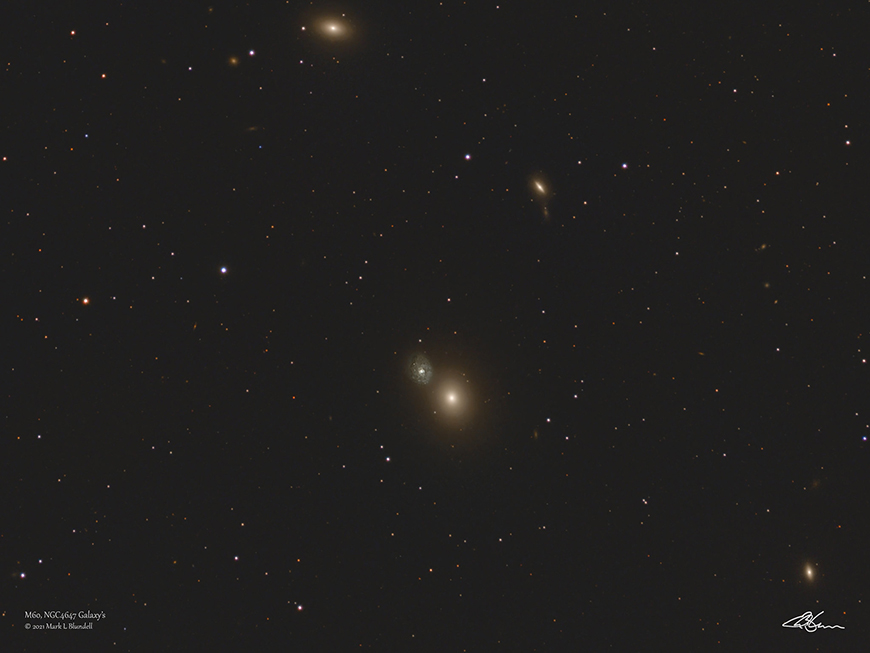
M59 (top) and M60 (middle) by Mark Blundell. Image used with kind permission.
Both M59 and M60 are thought to contain supermassive black holes in the order of mass equal or larger than the mass of M87's - with M60's thought to be a huge 4.5 billion solar masses.
If we trace a line back West from M60, to M 59, then back to M58, we have a starting point for the identification of the next target for this month, the Siamese Twins Galaxy or Butterfly Galaxy. This is in fact two objects, NGCs 4567 and 4568, which can be found just over half a degree to the SSW of M58. These objects are +11.30 and +10.80 mag respectively and can be resolved as a V-shaped patch of light in smaller telescopes. Larger (8-10-inch class) instruments will clearly resolve the objects as a much more rounded "V" - very reminiscent of a butterfly in flight, in fact. Larger instruments under good conditions will start to resolve some variance of brightness within the disks, but it is in astrophotography that this target really begins to show its true awesome beauty. Images reveal the early onset of a collision between these two spiral galaxies, which has been confirmed by professional infrared observations.
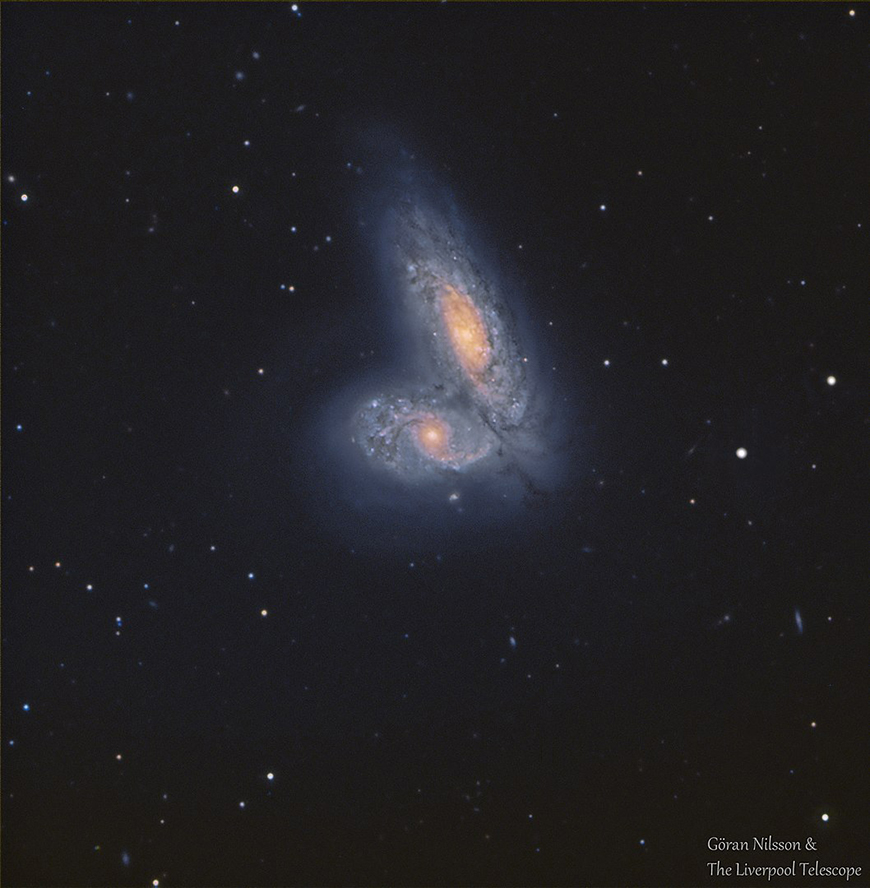
NGC4567 and NGC4568. Image credit: Goran Nilsson & The Liverpool Telescope. Creative Commons.
Following a line from M58, through the Siamese Twins, extending SSW by just over 3 and 1/2 degrees, we come to the penultimate object for discussion this month, the bright elliptical galaxy M49. M49 was discovered by Messier on 19th February 1771 and was the first of the Virgo group to be added to his list of objects. At +8.39 mag and 10.2 x 8.3 arc minutes dimensions, this galaxy is large, but still pretty bright - certainly conspicuous enough in binoculars under average conditions. Indeed, M49 is the brightest of all the Virgo cluster, though M87 does give it a run for its money. It was thought that both objects were of similar size and mass, but observations have now proved than M87 is by far the larger and heavier of the two galaxies. By comparison, M49 has "only" 6000+ globular clusters to M87's 12000+.
4 degrees to the SSW of M49, extending the imaginary line we stared from M58, we come to the final objects in this month's epic tour of just some of Virgo's Deep Sky delights. This object is one of the most beautiful and the most active, M61.
M61 was discovered by Barnabus Oriani on 5th May 1779 and was also noted on the same night by Messier, who classed it as a possible comet. Less than a week later, Messier had realised that M61 was a static object, so then added it to his list.
At +9.69 mag and 6.5 x 5.9 arc minutes, M61 is a fairly compact galaxy, having a bright star-like core, surrounded by evidence a its face on spiral nature, which is visible in smaller telescopes as a tenuous halo, but is resolved much more readily and successfully by the 12-inch+ class of telescope into a definitive spiral. In fact, M61 is another barred spiral, but this bar is very compact in comparison to virtually every other barred spiral galaxy previously mentioned here. Again, M61 is a worthy target for astrophotographers, who will pick up this compact spiral's structure well in long duration photographs.
M61 is unusual in being one of the most active star-forming galaxies in the Virgo cluster.Likewise it holds the joint record with M83 as being the most active Messier object for Supernovae, with six being observed in the the past century.
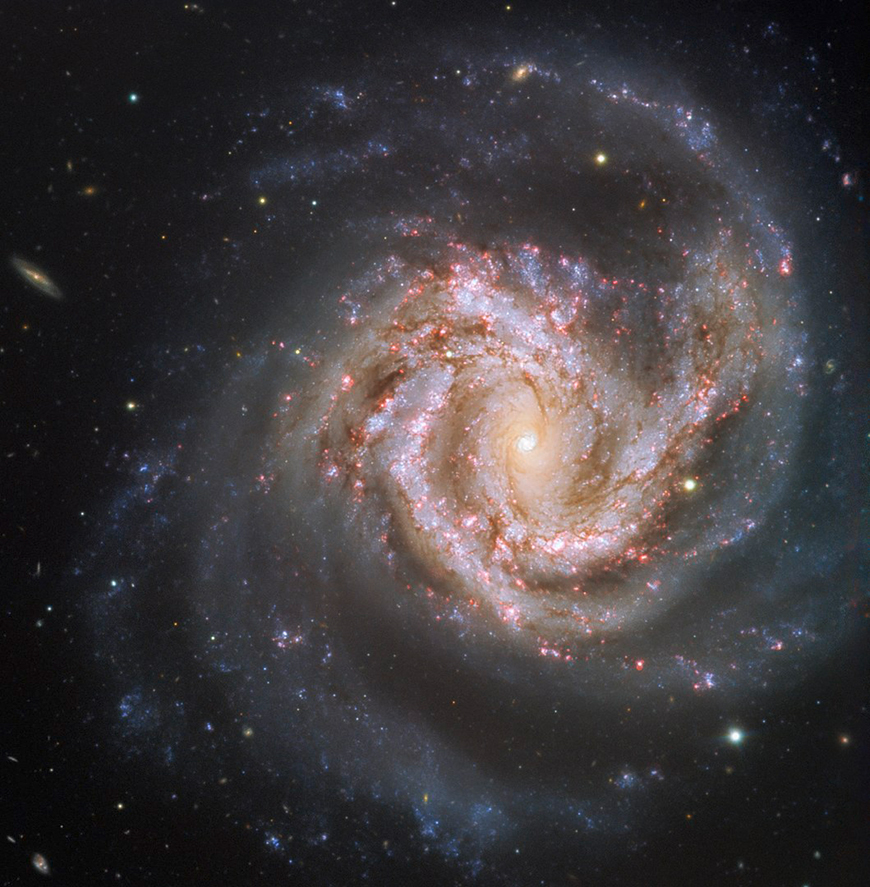
M61. Image credit: ESO/VLT. Creative Commons.
From M61, we can trace a curving arc to the SE in the direction of Spica, Virgo's principle star, which takes in a few of Virgo's lesser galaxies, the elliptical +9.50 NGC4636 is exactly 5.5 degrees SE of M61, followed by the +10 mag spiral NGC4753, then reaching NGC4697, which is a brighter elliptical galaxy, discovered by William Herschel in 1784. This galaxy is fairly easy in small telescopes, as is its neighbour NGC4699, an attractive but compact spiral, which lies just under 3 degrees due South.
At the bottom of this arc, 3 and 3/4 degrees to the SW of NGC4699, lies one of the jewels of the night time sky, M104, the Sombrero Galaxy. The Sombrero was discovered in 1767 by Pierre Machain and though noted by Messier in an addendum to his original list, had to wait until Camille Flammarion rediscovered it in Messier's original notes in the early 1920s for it to be officially added as a Messier object. William Herschel made an independent discovery of it in 1784 and remarked upon the appearance of a "dark stratum" in the object. We now know this to be a prominent dust lane which rings the outer spiral structure of the Sombrero and gives it its distinctive - and apt - nickname.
The Sombrero is bright for a galaxy at + 8 mag and a decent size, (though hardly over-large) at 8.6 x 4.2 arc minutes in dimensions. It can be found in telescopes and binoculars of all sizes, though contrary to what is stated in many publications (which tend to overstate the size of telescope required), a good quality 4-inch refractor and a dark observing site and decent dark adaption will be needed to see its dust lane. Admittedly, the lane is much easier with a reflector of 8-10 inches in aperture, which will also resolve the true shape of the Sombrero better, but this should not put off observer with smaller instruments from attempting to spot it. Once found, M104 will not be forgotten in a hurry, it is a lovely object. M104 is even more spectacular when imaged, though from UK locations astrophotography of this target has to be timed carefully, as it is only at a reasonable height from the horizon for a limited period.

 English
English